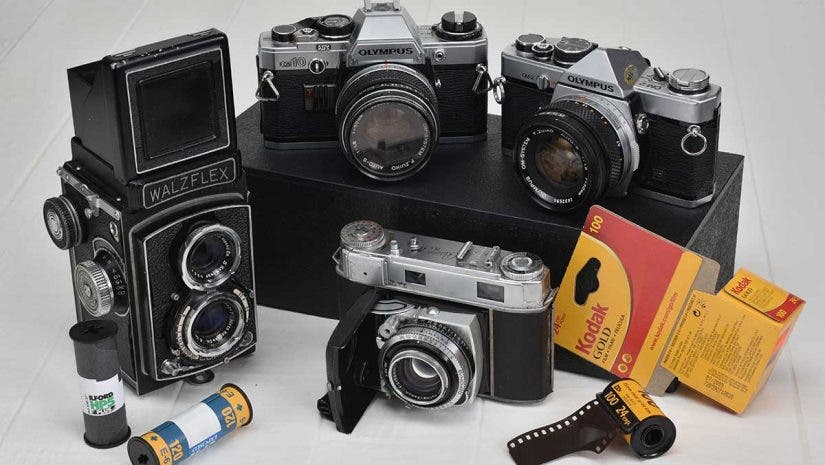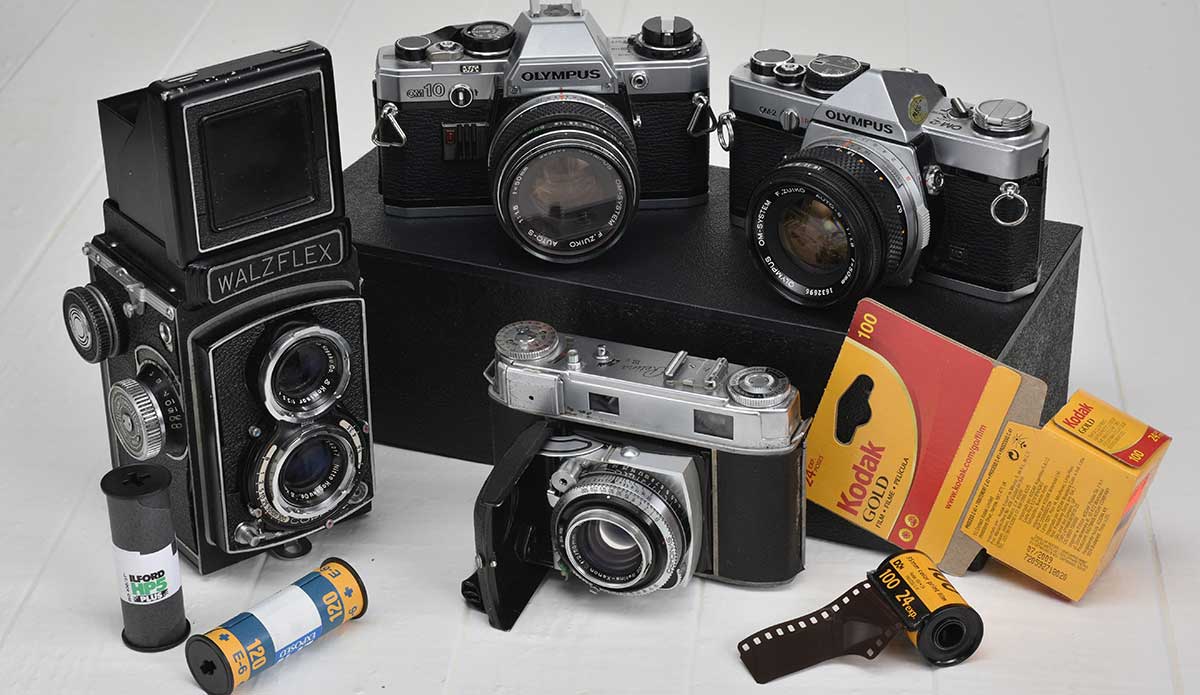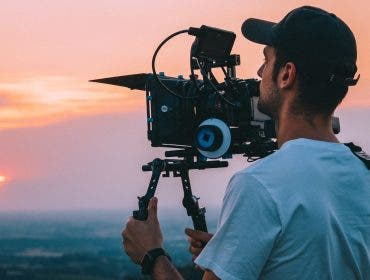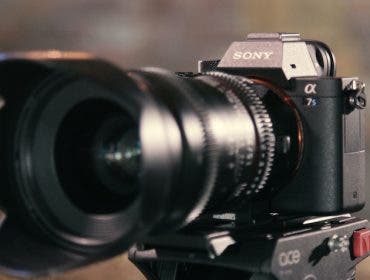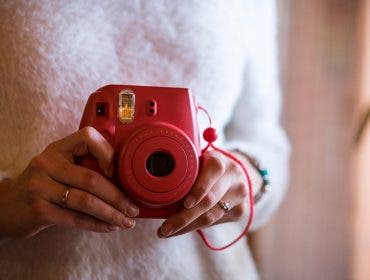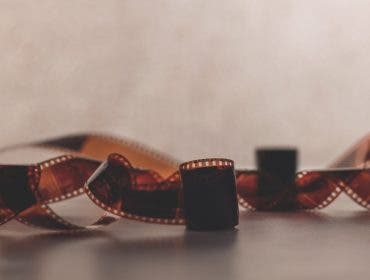Despite the ongoing improvements in digital imaging technology, analog film cameras remain a popular (and beloved) instrument for many photographers. In fact, film has been witnessing a resurgence in popularity among professionals and amateurs alike—even gadget-obsessed millennials are ditching their smartphones and digital cameras for old school film cameras.
Unlike digital photography, working with film can be quite tricky. You have to be very selective about the images you take, as you don’t want to waste film. You also don’t have the option of cropping out unwanted elements or adjusting the exposure of a particularly dark image (unless you own a film scanner) with photo editing software later on. And of course, the entire process of turning your film into an actual photo is an arduous one as well.
Analog cameras capture images by exposing photographic film to light, with the scene in front of the lens being reproduced onto the material thanks to the chemical reaction between the silver halides and the light itself. You then develop film in a darkroom and turned into an actual photographic print. It’s much more complicated than it seems, but that’s part of what makes it fun for most photographers.
Other reasons why people are turning to cameras that use film are that film offers a variety of creative and technical advantages—such as higher dynamic range, superior color saturation and accuracy, and the ability to experiment with double exposure. Additionally, film cameras are generally more affordable—some typically have a higher resolution as well—than many of their digital counterparts. Also, black and white pictures tend to be more detailed when shot on film due to the higher dynamic range.
If you’re interested in learning more about the different film cameras, as well as the various film formats and types available, then continue reading.
Types of Film Cameras
- Single-Lens Reflex (SLR) Cameras
- Twin-Lens Reflex (TLR) Cameras
- Rangefinder Cameras
- Point-and-Shoot Cameras
- Instant Cameras
- Stereo Cameras
- Panoramic Cameras
- Folding Cameras
- Large Format Cameras
- Box Cameras
- Pinhole Cameras
- Toy Cameras
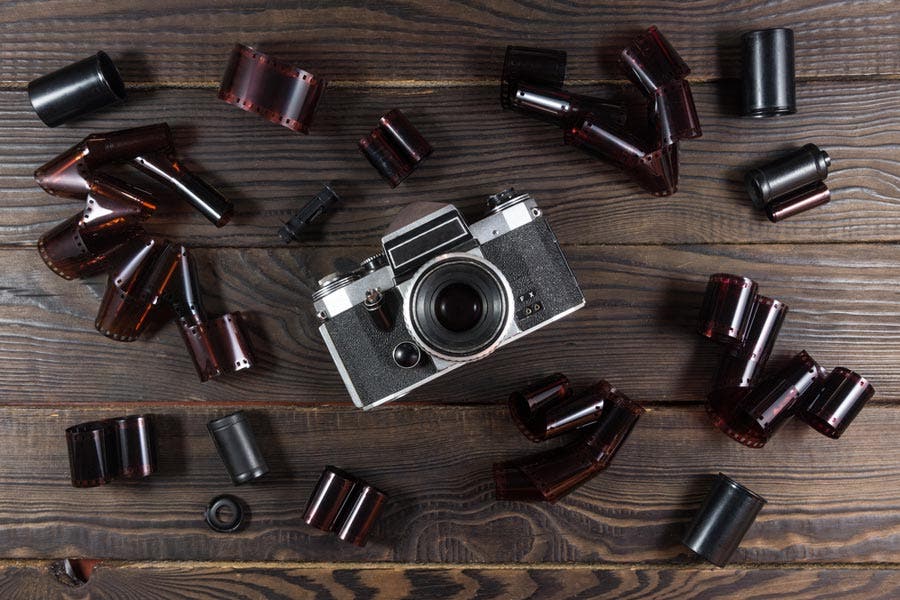
Single-Lens Reflex (SLR) Cameras
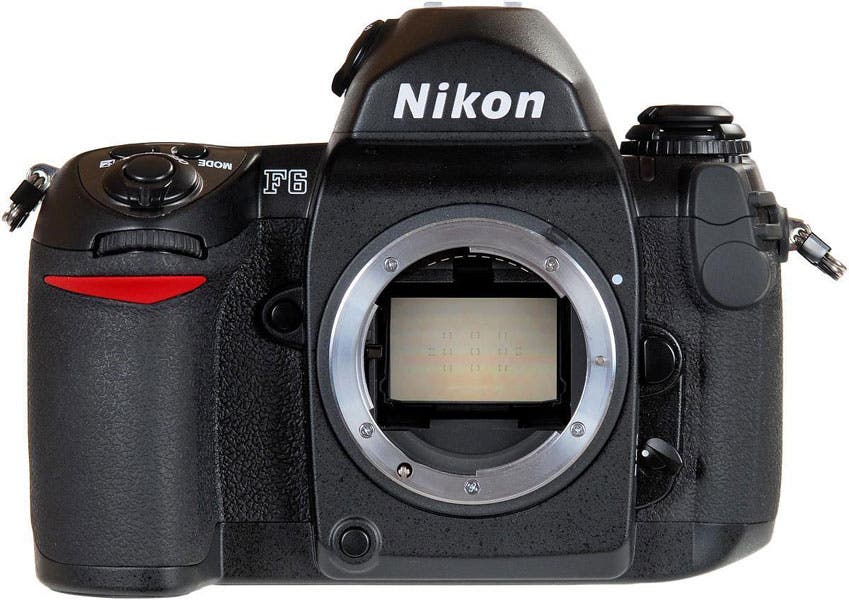
These cameras are the analog equivalent of the DSLR. It has the same internal mirror mechanism that allows you to look straight through the lens and see a near-exact approximation of what the image will look like. SLR cameras also allow you to swap lenses, enabling you to exert greater control over your shots.
One of the primary benefits of using an SLR for film camera photography is that most camera manufacturers design the lenses for SLRs and DSLRs to be interchangeable (to a point). For that reason, many photographers who begin with one brand of SLR tend to stay with that brand when upgrading to a DSLR, or vice versa.
SLR cameras use 35mm film, which is very common and easy to find. Whether you prefer color film or black-and-white, you’ll have plenty of film options for your SLR. In fact, it’s often easier to find film for a 35mm camera today than it is to find a newly manufactured SLR.
Twin-Lens Reflex (TLR) Cameras

Equipped with double objective lenses of identical focal lengths, twin-lens reflex or TLR cameras are able to continuously display the scene you are trying to shoot on the viewfinder screen—they do not “black out” during exposure like SLRs do. One lens is used for viewing while the other lens exposes the film, and thanks to these separate lenses, you can examine the scene as the camera takes the shot, which can be helpful for certain applications that require longer shutter speeds.
Some TLR cameras feature a pop-up magnifier for improved focusing. That can be very helpful for achieving tack-sharp focus on your subject.
While TLR cameras were quite popular when they were introduced, they’re not as popular today because of a few major limitations.
- First, most models don’t offer lens interchangeability, so they’re not quite as adaptive as other types of film cameras.
- Second, you have to hold TLR cameras at waist or chest height for ease of focusing and framing. That’s because the viewfinder is on top of the camera, so shooting from overhead is nearly impossible.
While TLR cameras are great vintage cameras for street photography and casual portraiture, they’re less ideal for other film camera photography applications.
Rangefinder Cameras
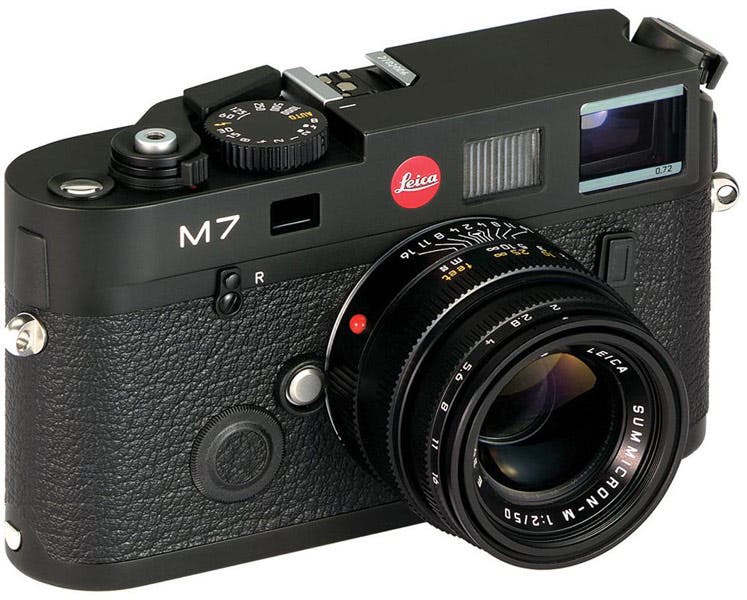
The most distinguishing feature of a rangefinder camera is that it calculates distance through triangulation for accurate focusing. It uses a somewhat similar mechanism as the SLR, except that this mechanism, which involves a compact revolving mirror and two windows, is used for focusing—not for viewing the scene to be captured. Also, unlike the SLR, a rangefinder does not allow you to look through the lens, but through a small window on the upper right side (in the same way you would with a point-and-shoot camera).
Because of the viewfinder’s location, the image you plan with your rangefinder camera will never be exactly the same as the exposure you take. In many cases, this is a minor irritation, but it does prevent rangefinders from having the same level of shot predictability as other types of film cameras.
Most rangefinder cameras take 35mm film so it’s easy to find supplies for them. Because they don’t need to accommodate a mirror like an SLR, rangefinder cameras are much smaller and their lenses are also much more compact. This can result in a more mobile kit that you’re more likely to carry with you.
Point-and-Shoot Cameras
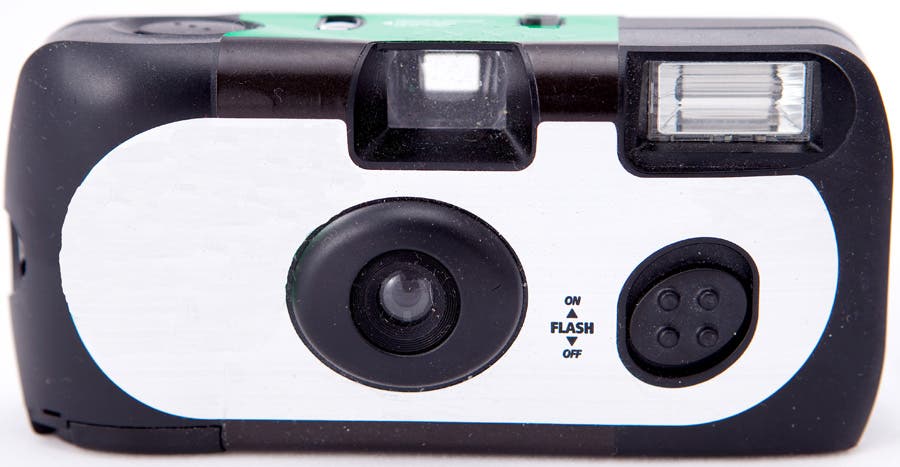
Without mirrors or any of the other complex mechanisms found in more sophisticated cameras, point-and-shoots are generally very compact and lightweight. These are what people call “disposable” or one-time-use cameras. They cannot be reloaded with a new roll of film. As the name suggests, point-and-shoot cameras don’t allow you to do anything other than point and shoot. The camera controls focus and exposure settings automatically, plus it has a fixed focal length lens so you won’t be able to zoom in or out.
Point-and-shoot film cameras are extremely straightforward and easy to use. Beyond adjusting the camera for the speed of film you’ve selected, there’s little for you to do as the photographer. That’s why point-and-shoots are considered beginner film cameras. They are less popular with serious photographers.
Some point-and-shoot cameras are motorized and automatically advance your film to the next frame after you click the shutter. Others require you to advance the film by hand with a small lever near the shutter button.
Point-and-shoot cameras are among the least expensive film photography cameras because they’re less sophisticated than other types. They’re great starter cameras that use film, especially for kids who are interested in learning film photography.
Instant Cameras

One of the most popular film cameras today, the instant camera is essentially a point-and-shoot camera that prints images instantaneously on self-developing film. Some models even allow you to choose from several shooting modes or adjust the brightness of the image for better results. The appeal of this camera lies in its ability to satisfy our desire for instant gratification—you’ll be able to see your photos immediately after capturing them, much like with a digital camera. And unlike most of the film cameras on this list, this type of camera is still manufactured today.
Polaroid was the most well-known manufacturer of instant cameras and film until the company went bankrupt in 2001. Eventually, the Polaroid brand was sold off and reintroduced as a manufacturer of instant cameras and film.
Today you can buy instant cameras and film by the new Polaroid company as well as Fujifilm and Canon. Instant film is available in a variety of sizes and ratios specific to each camera type. Many instant cameras use modern technology to produce small prints quickly without the use of chemicals required by the original Polaroid models. Some instant cameras even capture a digital image at the same time. Check out our list of the best instant cameras on the market to find the best one for you.
Stereo Cameras
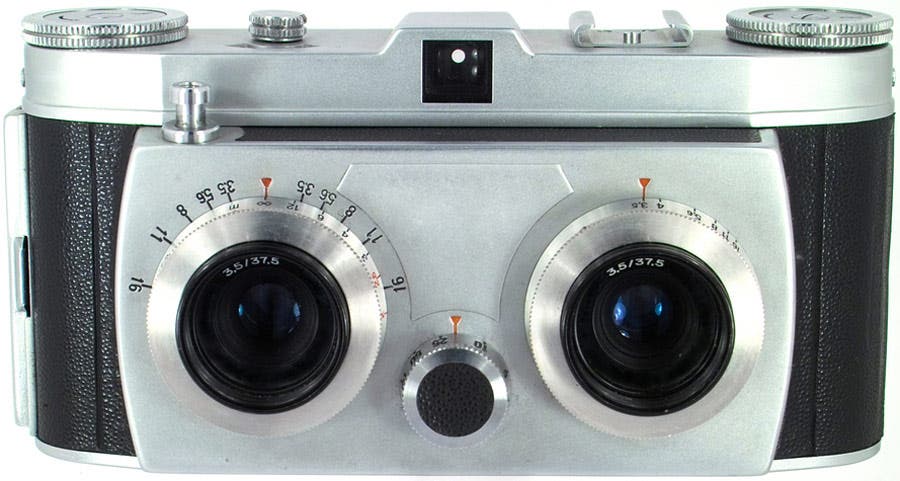
Stereo cameras can reproduce human binocular vision and shoot images with 3D effects, all thanks to its multiple lenses and their respective image sensors or film frames. There are a number of possible uses for stereo cameras, including range imaging and the creation of stereoviews and 3D pictures for movies.
Stereo camera prints were a popular household accessory in the first half of the 20th century. Many families had a collection of stereo prints and an image viewer called a stereopticon. Stereopticon viewers consisted of a mounting frame where you could insert a stereoscopic print, an eyepiece that fit over the viewer’s eyes for the ideal perspective, and a handle for holding the stereopticon comfortably.
When they were first developed, stereopticons were modern marvels. They introduced the concept of 3D imagery and were a big hit at the 1900 International Exposition in Paris.
Panoramic Cameras
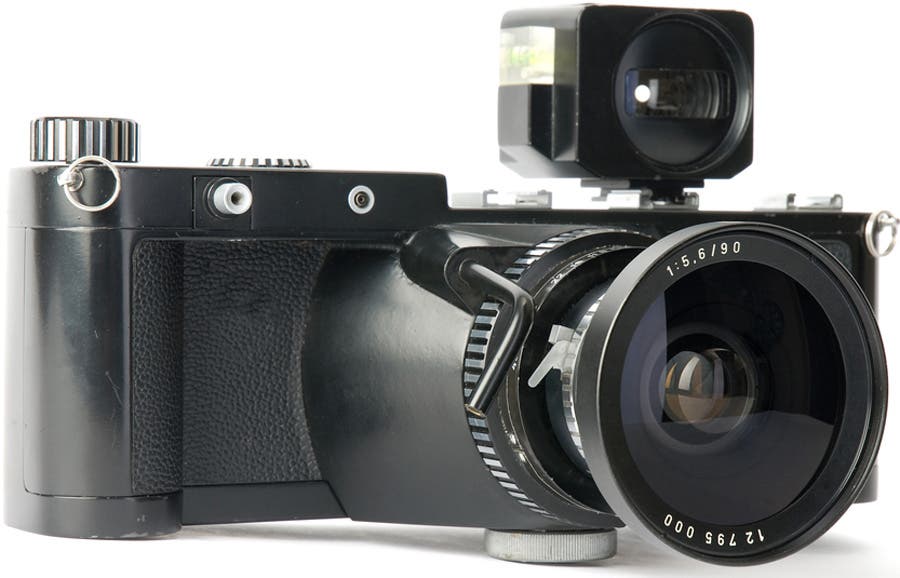
Panoramic cameras have been around since the 1800s. The first successful model, the Megaskop, was created by German-born photographer Friedrich von Martens in 1844 or 1845. Various photographers and inventors created their own version of the panoramic camera over the last two centuries, each with different mechanisms and components. What all of them had in common, however, is that they were able to compose large, highly detailed images by fully utilizing the entire film frame.
In digital photography, most panoramic images work by digitally stitching multiple frames together. But in the days of film photography, panoramas were traditionally created in a single exposure.
Some modern panoramic cameras feature an internal motor that rotates the camera from one side to the other during the exposure to fully capture the scene. Other panoramic cameras simply use a wider portion of film than a traditional 35mm camera.
To be considered panoramic, an exposure needs to be twice as wide as it is tall, or have a 2:1 ratio. Some panoramic cameras take much wider images with resulting exposures of up to a 10:1 ratio.
Folding Cameras
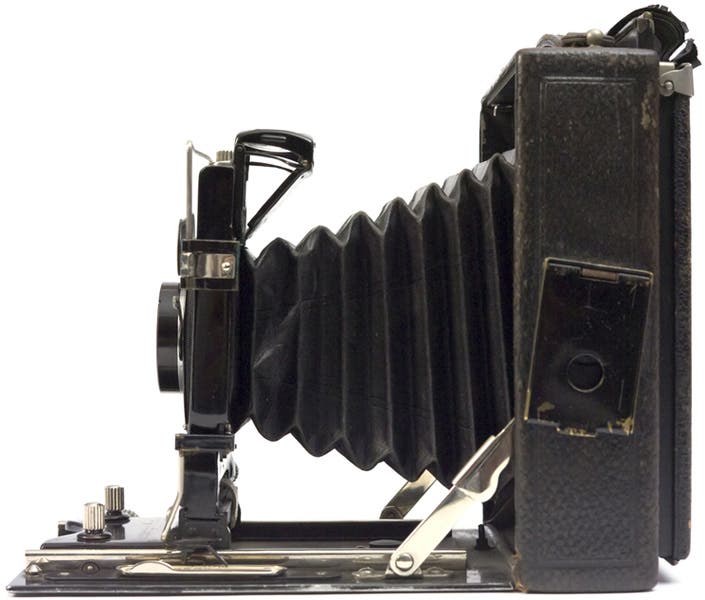
One distinct feature of the folding camera is its bellows—which looks like what you see on an accordion instrument—situated between the lens and the camera body. This part can alter both image focus and in-camera effects, as well as fix distortion in certain cases. You can also achieve different effects for your image by adjusting the lens angle and position at the bellows’ edge and the film back.
Folding cameras were very popular when they were first developed because they could be transported more easily than larger box cameras. Their compact size and lighter weight was more practical for travel and casual use.
In order to take a sharp and focused image, photographers needed to fully unfold the camera’s bellows.
Most early folding cameras used large format film and produced postcard-sized negatives. Eventually these models fell out of favor because photography enthusiasts preferred smaller-sized film for more practical use. Some 35mm folding cameras did eventually hit the market, but they never caught on widely with consumers.
Large Format Cameras
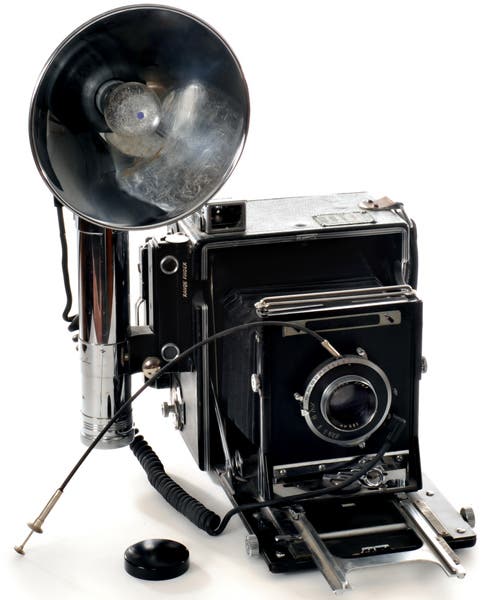
A large format camera is technically any camera with an imaging format of at least 4×5 inches (102×127 mm) or bigger. Unlike other cameras on this list, large format cameras are not limited to a specific camera design or mechanism. It can be a rangefinder, an SLR, a twin-lens reflex, or even a pinhole camera.
Large-format cameras were favored by many landscape photographers like Ansel Adams because they could produce extremely large prints with more detail and greater depth of field than most other types of film cameras.
Taking photos with a large-format camera is a very intensive process that takes time and attention to detail. Setting up the shot requires effort and greater photographic knowledge than with simpler cameras like 35mm SLRs. For that reason, large-format models don’t make great beginner film cameras.
Large-format cameras generally require tripods because they’re very heavy. They also take more time to set up and prepare for each exposure.
Box Cameras

As the name suggests, box cameras come in the form of a cardboard or plastic box, with a lens on one end and film on the other end. In order to create images, these simplistic cameras have an aperture that captures light, which is then burned onto the negative.
Box cameras were popular when they first came out because they were simple to use and very inexpensive. These basic cameras lack the more sophisticated aspects of other cameras like the ability to set shutter speed or adjust focus. They function most effectively in brightly lit scenes.
The most well-known example of a box camera was the line of Brownie cameras by Kodak. These were marketed to children because they were so inexpensive and easy to use. Most Brownie camera models used 120 film, which is still available today for photographers who want to experiment with easy-to-use vintage cameras.
Pinhole Cameras
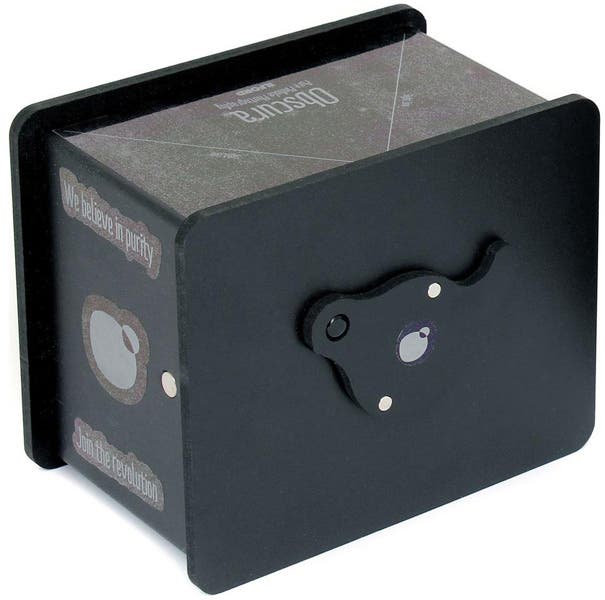
A pinhole camera (or “camera obscura”) is a sealed box or chamber with a tiny hole or aperture on one side. It creates images by allowing light to pass through the pinhole and projecting an inverted image on the opposite side of the chamber and onto the film or photographic paper.
Pinhole cameras are characterized by an immense depth of field and a very wide camera angle.
Pinhole cameras are easy to make and experiment with at home, so they’re a popular craft project for families and kids’ photography classes. Also, because pinhole cameras don’t require a lens, there’s no risk of distortion or missed focus. Wide-angle images are perfectly rectilinear and appear natural.
Today’s pinhole cameras aren’t only used for film photography. They are a popular method of viewing solar eclipses because they let the viewer see the shape of the sun without risking eye damage. Instead of using a piece of photographic paper, you can leave the back of your pinhole camera open. As the moon passes in front of the sun, the eclipse will cast a shadow on the ground.
Toy Cameras
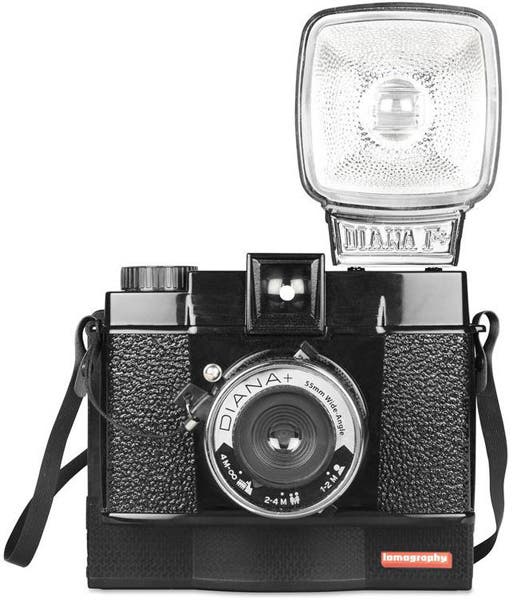
Toy cameras are normally made of plastic and are very easy to use, making them suitable for children. They’re also capable of shooting decent images regardless of the various defects in their lenses. Some lomography cameras, like the Diana F+ Medium Format Camera, can be categorized under this film camera type.
Toy cameras are popular analog cameras among contemporary photographers who are interested in a retro or vintage look. By using unique films and cross processing when developing the film, images can achieve a bold, bizarre, and artistic look.
Lomography is one of the most popular manufacturers of contemporary toy cameras, but Holga and Vivitar also produce unique and interesting toy camera models.
If you’d like to play with the style of analog cameras but aren’t interested in film photography, you can try mounting a toy lens on your DSLR. The plastic lens elements produce interesting effects and distortions even when paired with a high-end digital camera.
Types of Photographic Film

Color Negative Film
This type of film is popular among portrait and wedding photographers because of their vivid colors and contrast. C-41 chemicals found in color negative film yields negatives and prints through regular image processing.
Color Positive Film
Color positive film produces colorful images or slides through regular image processing. It contains E-6 chemicals, which can be used with C-41 chemicals (color negative film) to create photos with intense contrast and bright colors, as seen in lomographic photos. This is known as cross-processing.
Black and White Film
Black and white film comes in two types: “traditional” B&W film and C-41 B&W film. Traditional or Silver Gelatin B&W film uses gelatin with small silver salt crystals dispersed in the substance—hence the term “Silver Gelatin.” It is considered more stable and entails a much simpler developing process (as compared to the C-41 B&W), which is why it is typically the preferred film of B&W shooters. On the other hand, C-41 B&W film has numerous layers that are all sensitive to light, plus it involves a painstaking developing process that is easy to mess up. Also, exposure to various colors of light can make them unstable, and they often produce inconsistent results.
Infrared Film
With the right exposure, you can produce quirky photos using infrared film. This type of film is sensitive to a broader spectrum of light than human eyes and can yield surreal-looking images when exposed correctly. True infrared film can only be loaded and unloaded in complete darkness, making them best for more experienced photographers.
Common Film Sizes
- 135 or 35mm – 135 or 35mm film is both easy to find and process, as they’re available at drugstores and can be developed in one-hour photo laboratories. 35mm film produces images with a common size of 24x36mm.
- 120 or Medium Format – 120 film comes in various frame sizes, but the most common would be the 6x6cm. Depending on the frame size, it offers exposures of up to 15 or 16.
- Large Format – Large format film is generally at least 4×5 inches or 9x12cm, giving you around 15 times the resolution of the typical 35mm film. It also comes in other less common sizes, such as quarter-plate, 5x7in, and 8x10in.
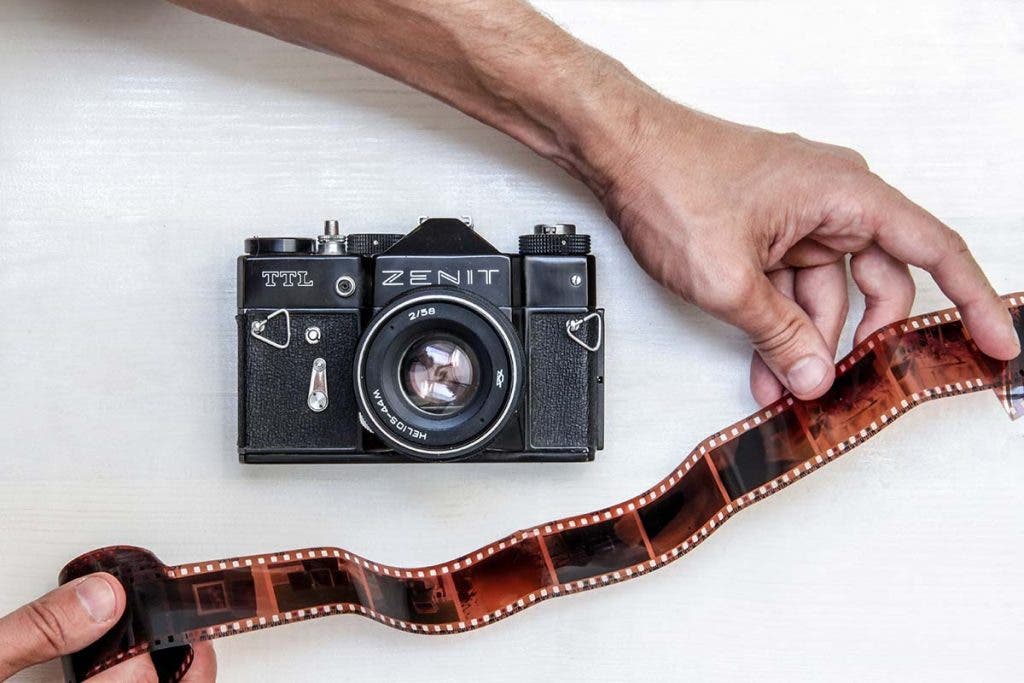
How Does a Film Camera Work?
While there is a wide variety of film cameras, most of them function in a very similar way. Photographic film, or a plastic substrate covered in a light-sensitive chemical emulsion, is mounted inside a light proof box or case. To take a photograph, the photographer clicks the shutter button, which opens a shutter (or small door) and exposes the film to light through the camera’s aperture or opening.
More elaborate film cameras use lenses to focus, magnify, or otherwise adjust the resulting image, though very basic cameras work without lenses. The lens’ aperture controls how much or how little light is allowed to reach the film. Apertures usually consist of multiple curved blades that not only limit the quantity of light, but also influence the depth of field, or how much of the scene is in focus.
Advancing Film
Most film cameras use roll film, which can accommodate between 24 and 36 individual frames or images. After each exposure, either the photographer or the camera’s motor needs to advance the film frame to protect the previous exposure from additional light while also preparing the next frame.
Some film cameras, like medium and large-format cameras, use sheet film which produces a single image at a time. After the film is exposed, the photographer removes the film from the camera and inserts another sheet of film for the next shot.
Modern film camera photography uses motors to advance the film, adjust the lens aperture, and rewind a roll of film when every shot has been exposed. Older film cameras required manual adjustment and control of each of these settings.
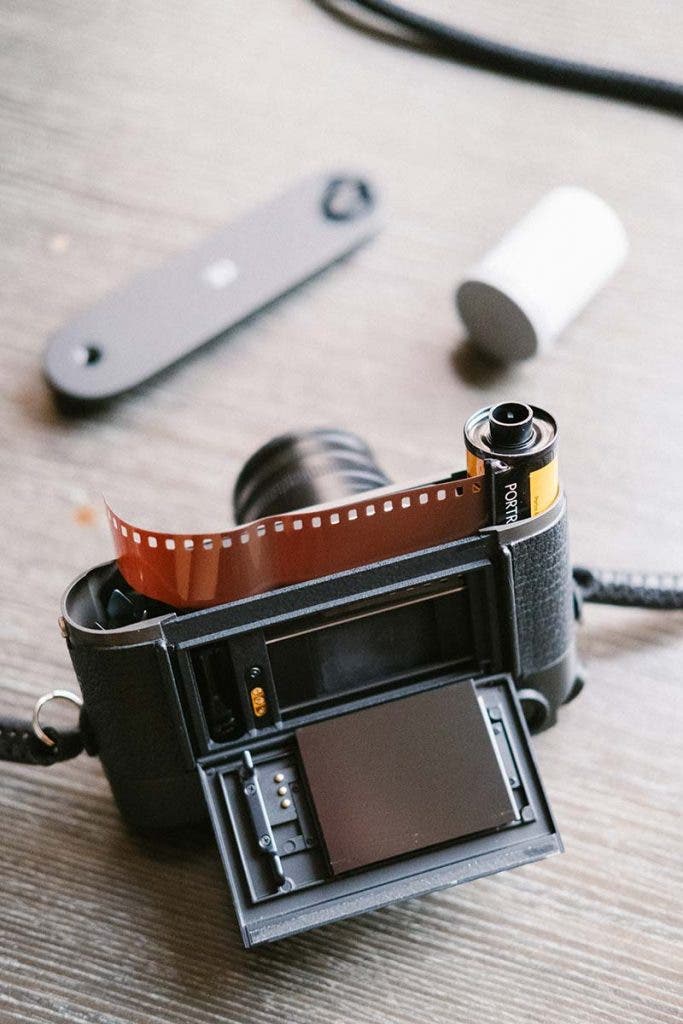
What’s the difference between an analog (film) camera and a digital camera?
On the surface, the difference between film cameras and digital cameras may sound simple: film cameras use thin plastic film strips to store images while digital cameras use a sensor to capture and store images within the device itself. But that’s just the beginning of differences between analog and digital cameras. Cost is another major difference between the two.
Photos taken with a digital camera are more affordable than those taken with a film camera. That’s because digital photographers have more storage, and can erase a photo and try again. With film, photographers have to cover the cost of each film roll and each photo. Each press of the shutter ends up costing the photographer money (you can’t simply delete and repeat; every shot counts).
Capacity is another big difference. Digital cameras can hold hundreds, or even thousands, of photos via memory cards, while film cameras hold a much smaller amount of photos per roll (typically 36 per 35mm film roll).
All that said, it’s hard to beat the final, soft aesthetic of a film camera—that’s why so many photographers have turned to (or never stopped using) their analog cameras.
How to choose an analog camera
With so many options out there, it can be intimidating to purchase a film camera. Here are some things to know before you start browsing.
The available 35mm film types include SLR (single-lens reflex), point-and-shoot/ compact, or DSLR (digital SLR); the latter has the most versatility with interchangeable lenses. One key feature to look for in your analog camera? Manual capabilities. While you could get an analog camera and solely use auto, it’s best to invest in a camera that will grow with you—and for that, you need a film camera that lets you shoot fully manual. To be clear: It’s OK if you only use the automatic features as you’re getting started! Learn to get comfortable with your camera, and the more you shoot, the more you’ll expand your skillset.
You’ll also want to look for a film camera with a built-in light meter so you don’t waste film with ill-lit shots. A battery-operated light meter is particularly helpful; that way you can change the battery yourself if it dies. It’s also important to go with an analog camera from a well-known brand, such as Canon or Pentax; they’ll be more likely to have parts available if you need repairs.
